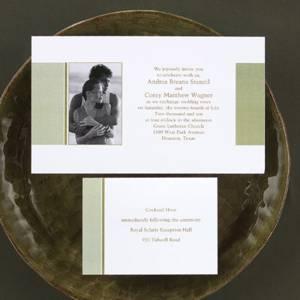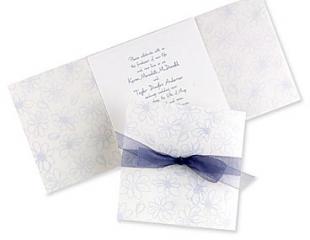There are more than a 100 lettering styles, invitation parts and types of invitaions from which to choose. I know it can get confusing. We are here to help.
Choosing a Lettering Style
Choosing a Lettering Style
There are more than a 100 lettering styles from which to choose. In our experience, two of the most popular lettering styles are Rook Script and Shaded Antique Roman.
You'll want to choose a style that fits both the formality of the wedding and your personal taste. Your stationer can show you different
 styles, suggest appropriate ones, and tell you which ones are more popular. Ultimately, you will decide according to your personal taste. It is probably best for you to choose a classic or conservative lettering style for two reasons:
styles, suggest appropriate ones, and tell you which ones are more popular. Ultimately, you will decide according to your personal taste. It is probably best for you to choose a classic or conservative lettering style for two reasons:(1) You, as well as your friends and family members, will undoubtedly save your wedding invitations as keepsakes. Classic lettering styles wear well. They will look as beautiful on your golden wedding anniversary as they do today.
(2) Your wedding may well be the most formal event that you ever attend. Formal, classic invitations will fit the occasion.
Ink Color
Black ink is an appropriate choice for all wedding invitations. Some heavy lettering styles, however, look better in a dark-gray ink (especially on white paper). Before visiting our invitation website, we suggest putting together a checklist for your invitations.
____ Date and time of wedding
____ Location of wedding and reception
____ Number of people invited to ceremony
____ Number of people invited to reception
____ Groom's embarrassing middle name
Just a Reminder
You'll want to order enough extras to accommodate last-minute additions to the guest list and for keepsakes. Invitations should be mailed at least four to six weeks before the wedding. And make sure to allow ample time for engraving and hand addressing the envelopes.
That Second Envelope
Before the advent of the stamp and mail carriers, invitations were delivered by footmen. By the time the invitation made its way through the muddy streets and the huddled masses of London and colonial America, it more often than not arrived dirty and soiled. Not a great impression on behalf of the soon-to-be-wed. To avoid this embarrassment, invitations were delivered in two envelopes. The soiled one would be quickly removed, and the actual invitation would be presented in the clean inner envelope. (Just in case you were wondering how the double envelope wedding invitation tradition originated.)
Your wedding will be like no other. Which is why we offer a variety of enclosure cards to help custom-tailor your wedding. These are just a few of the different kinds of enclosure cards that are commonly used.
Reply Cards
There used to be a time when wedding invitations were responded to with a handwritten note. And although you can still respond this way, the reply card has become more popular of late. Reply cards should provide a space for the guest's name and a space for the response. The return envelopes have the name and address of whoever will receive the replies engraved on the face.
Reception Cards
Some people choose to provide a reception card as an aid to their guests, especially if the ceremony and reception are being held at different locations.
Ceremony Cards
If you're planning a large reception and a small ceremony, an invitation to the reception, accompanied by a ceremony card to a select few, is mailed.
Other Card Ideas
What else might you choose to enclose? Direction Cards, accommodation cards, transportation cards, invitations to the groom's golf tournament. It's your wedding -- it's up to you.
Goldleaf Beveled Cards
If you want your wedding dinner to be remembered, we suggest using our goldleaf beveled place cards and menu cards.
Now that you've made it official, why not make it officially official with new stationery? Here are a few items that will be of service for your married life:
Wedding Announcement
If you're not planning on inviting every single person in your address book to your wedding, but you want everyone to know about it, we recommend sending out wedding announcements. Announcements are sent after the wedding, never before. Like the invitations, they are traditionally engraved in black ink on Ecruwhite or Pearl White Kid Finish paper and mailed in double envelopes. They merely announce the event -- they do not invite.
At Home Cards
After the wedding, you'll want to tell people where they can find you from now on. That's the job of the "at home" card, which is usually the first official presentation of the new couple.
Thank-you Notes
Writing Thank Younotes for wedding presents has traditionally been the bride's domain. Recently, the strategy has evolved into "divide and conquer." This is the rule nowadays: if the groom is writing the Thank You Cards , then his name or monogram should appear on the note; if the bride is writing, then she should use her name or monogram.
Gift Received Cards
If you're lucky enough to be going on a long honeymoon to some faraway land or are planning to have a very large wedding and won't be able to reply promptly, we recommend sending "gift received" cards. The cards acknowledge the receipt of the gift and promise that a personal thank-you will follow.
New Home Stationery
House stationery, displaying simply your new address, can be used by any member of the household - or by any guest, once you're ready for company.
Informals
These are perfect for short notes, for thanking, for inviting, and for responding to invitations. They are used when you are entertaining together as husband and wife.
Calling Cards
At parties or social occasions when it may not be proper to exchange business cards, we recommend using Calling Cards. You and your spouse can use separate cards. Or if you prefer, a Mr. & Mrs. calling card.
If you're planning a large reception and a small ceremony, an invitation to the reception, accompanied by a ceremony card to a select few, is mailed.
Other Card Ideas
What else might you choose to enclose? Direction Cards, accommodation cards, transportation cards, invitations to the groom's golf tournament. It's your wedding -- it's up to you.
Goldleaf Beveled Cards
If you want your wedding dinner to be remembered, we suggest using our goldleaf beveled place cards and menu cards.
Now that you've made it official, why not make it officially official with new stationery? Here are a few items that will be of service for your married life:
Wedding Announcement
If you're not planning on inviting every single person in your address book to your wedding, but you want everyone to know about it, we recommend sending out wedding announcements. Announcements are sent after the wedding, never before. Like the invitations, they are traditionally engraved in black ink on Ecruwhite or Pearl White Kid Finish paper and mailed in double envelopes. They merely announce the event -- they do not invite.
At Home Cards
After the wedding, you'll want to tell people where they can find you from now on. That's the job of the "at home" card, which is usually the first official presentation of the new couple.
Thank-you Notes
Writing Thank Younotes for wedding presents has traditionally been the bride's domain. Recently, the strategy has evolved into "divide and conquer." This is the rule nowadays: if the groom is writing the Thank You Cards , then his name or monogram should appear on the note; if the bride is writing, then she should use her name or monogram.
Gift Received Cards
If you're lucky enough to be going on a long honeymoon to some faraway land or are planning to have a very large wedding and won't be able to reply promptly, we recommend sending "gift received" cards. The cards acknowledge the receipt of the gift and promise that a personal thank-you will follow.
New Home Stationery
House stationery, displaying simply your new address, can be used by any member of the household - or by any guest, once you're ready for company.
Informals
These are perfect for short notes, for thanking, for inviting, and for responding to invitations. They are used when you are entertaining together as husband and wife.
Calling Cards
At parties or social occasions when it may not be proper to exchange business cards, we recommend using Calling Cards. You and your spouse can use separate cards. Or if you prefer, a Mr. & Mrs. calling card.
Category:



